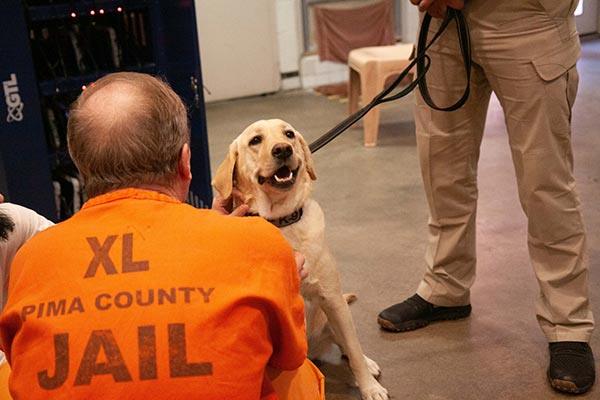Story by Brian Pettepiece Photos by Candice Eaton and Brian Pettepiece
Dogs bring joy into our lives simply by being themselves. With their consistently positive demeanor and undeterred happiness they can easily cheer us up when we’re feeling down or when we need a friend. Dogs are indeed unique animals that carry a kinship with us and have the ability to comfort us, to be our best friend. This is what makes therapy dogs so special. Therapy dogs are unique in that it is actually their job to bring that joy to others, to provide comfort where it’s most needed. And it’s a job that they love doing.
The Pima County Sheriff’s Department now has five such therapy dogs, whose job it is to improve the lives of those they meet. These dogs, all Labrador retrievers, spend all their time with their handlers, including going home with them at night, and serve the public in three different roles: as part of the Canine Crisis Response Team (CCRT), in Corrections Pet Assisted Stress Therapy (CPAST) or with the School Resource Officer Team (SROT).
Pima County Sheriff Mark Napier stated that the Labrador breed was chosen because of their trainability and lack of aggression. While some breeds can have aggressive tendencies that are more suited to other tasks, he said that labs are more likely to just want to run around and have fun. In addition, he stated that labs are generally a compliant, people-oriented dog; qualities that make them perfectly suited to therapy work. Stressing how therapy dogs can have a positive effect on people, “when you pet a dog it just makes your blood pressure go down,” Sheriff Napier said. “Humans have a unique relationship with dogs,” and it’s this relationship that enables the Department’s therapy dogs to have such an impact on the people they meet every day.
The purchase of the dogs was made possible by the financial assistance of an organization called Arizona Complete Health. This partnership between the community and law enforcement allowed the Department to not only acquire the dogs but also helps to pay for their food and equipment.
One way that the Sheriff’s Department’s therapy dogs interact with the community is through schools. Echo is an eighteen-month-old black lab handled by School Resource Officer Deputy Brittani Caudillo at a local middle school. Deputy Echo regularly plays a role in destressing students who may be having a difficult time, sometimes just by merely being present. Deputy Caudillo described one interaction she and Echo had with a child that was having a particularly difficult time at school that day. After the child told Caudillo that he didn’t like dogs, she offered to walk with him back to his class instead, keeping Echo off to the side and away from him. Back in class, Echo, probably able to sense that the child needed help, gently placed his head on the child’s knee. After a few moments the child began to pet him and before long he had completely relaxed. Echo had relieved the stress that the child was feeling simply by spending time with him. Caudillo said that “there’s been a lot of kids that say they don’t like dogs and don’t have dogs at home, but they love him.” She said that many kids have said that Echo is why they like coming to school, and if he’s not there it’s not as good of a day. It’s interactions like these that make Echo’s job so important. Therapy dogs have the ability to relieve tension and to relax people, qualities that go a long way in helping students who may be having a particularly bad day or are going through a stressful situation.
Deputy Nova is a yellow lab that works with School Resource Officer Deputy Lynsey Cole at a local high school. Cole describes Nova as sweet and docile and said she’s amazed how much Nova helps boost the morale of the school staff. Cole said that a lot of teachers tell her how it made their day just being able to see her. “You wouldn’t necessarily think that would happen, but I hear it all the time” she said. And hearing things like that reminds Cole of the important role that Nova plays with the students.
Officer Leo, a three-year-old yellow lab, was the Department’s first therapy dog. Detectives Charles Garcia and Nicole Crowson are Leo’s handlers. Leo is part of the Crisis Canine Response Team (CCRT). He mostly works intra-departmentally with officers who have gone through stressful situations, helping them through trauma that they have been exposed to on the job. Garcia said that Leo is “taken out to critical incidences in order to help get everybody back to a sense of normalcy” after experiencing a stressful situation. One example of Leo’s expertise was recently seen in his interaction with officers that were involved in an officer involved shooting. “He helped them to decompress,” Garcia says. Just by being around the officers and offering them the chance to relax and pet him, Leo helped them work through the stressful situation they had experienced. Being in a relaxed state can also help officers deliver better statements and have better recollections of incidents.
Perhaps one of the most interesting jobs that the Sheriff’s Department therapy dogs do is performed by Luke and Leia. Both yellow labs and siblings, they live and work at the Pima County Detention Center. Luke’s handler is Corrections Officer John Dickinson and Leia is handled by Corrections Officer Dominick Anaya. Dickinson says that the dogs serve multiple roles at the jail, visiting with both the inmates and the staff. By visiting with both staff and inmates, they reduce the stress level of both which helps to reduce confrontations, assaults and improves the overall mental health outcome of everyone that the dogs meet. Luke and Leia “basically, make it a little better place to be,” said Dickinson.
One of the places that the dogs regularly visit is the jail’s intake area. Dickinson described this area as being one of the highest tension areas in the facility. With new inmates being checked in, many whose first time it is being in jail, it becomes quickly apparent that being incarcerated can be a stressful experience. The dogs’ ability to calm an area down just by being present in the room both reduces the chances of injury due to confrontations but also can help smooth relations between staff and inmates. Petting a dog has a calming effect and can improve a person’s mood, two positives for canine and human interaction.
Seeing the positive impact that these therapy dogs have in the jail is really something special. Immediately upon walking into a housing pod with the dogs for a visit with the inmates, the mood is rowdy. The inmates have just been let out for some recreation time and there’s tension in the room, with lots of movement and loud voices. After five minutes, the room has calmed down. Not only are the dogs on their backs getting their bellies rubbed, but some of the inmates are on the floor with them, petting them and even getting licked. The room has become full of smiles with inmates asking about the dogs, waiting their turn to pet them, and telling stories about their own dogs. Luke and Leia are lapping up every second of the attention.
In the middle of the calming scene, one inmate said that seeing the dogs not only helped with his depression but also helped him get over his fear of dogs. As Luke and Leia help him overcome his phobia, he said that “it shows me that not all dogs are mean and want to attack me.” Another inmate said that visiting with the dogs really has made an impact on him, stating that “it definitely brings me peace” to see the dogs. He grew up with dogs and was heartbroken when he lost his childhood dog. He likes Leia in particular and says that she always goes right to him when she comes to visit. He also recounts a story about another inmate whose dog had died while he was in jail. Almost sensing that this inmate needed some comfort, Leia went right up to him and gave him some loving attention.
Seeing the palpable effect that these therapy dogs have on both the jail’s inmate population and staff is truly unique and is helping to make the Pima County Detention Center a national leader in corrections. Sheriff Napier stated that as far as they know they are the only county detention facility to keep therapy dogs on staff, not just bring them in for periodic visits. “We know that people in jail are sometimes having mental health issues or substance abuse issues,” he said, and the calming effects of petting a dog can have real mental and physical benefits. Seeing the results of having Luke and Leia on staff at the jail proves that this is true.
As the Pima County Sheriff Department’s therapy dog program rolls into its third year, it has become more successful than anyone had anticipated. All five dogs have made an impact on the Pima County community. Leo, the Department’s first therapy dog, who made community outreach easier and more accessible, continues to help reduce stress on officers who have experienced on-the-job trauma. Echo and Nova are two dogs making school more comfortable and welcoming for students. And Luke and Leia are having a measurable effect on people who live and work at the county jail. With these five amazing dogs, it’s easy to see the difference being made in people’s lives every day.
Operating this therapy dog program shows that the Pima County Sheriff’s Department is a true community partner, not just helping to keep the community safe, but also making it a more welcoming place to live. It can easily be observed that these dogs are making a difference, and truly living up to their mantra of being our best friends. The Department looks forward to this successful program continuing well into the future. And if you’re lucky enough to see one of these amazing labs out in our community, say hello. They would like to make your life a little better just by being themselves.













